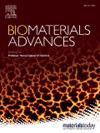Low-density electrospun fibrous network promotes mechanotransduction and matrix remodeling in fibroblasts
IF 6
2区 医学
Q2 MATERIALS SCIENCE, BIOMATERIALS
Materials Science & Engineering C-Materials for Biological Applications
Pub Date : 2025-04-09
DOI:10.1016/j.bioadv.2025.214316
引用次数: 0
Abstract
The mechanical interactions between cells and fiber-dominated extracellular matrix (ECM) are crucial in regulating matrix-remodeling and cellular physiological processes. Electrospun fibers, as a type of biomimicking fibers, provide an ideal platform for engineering a variety of tissues in vitro. However, the mechanisms by which electrospun fibers promote cellular matrix-remodeling, particularly concerning the characteristic mechanical compliance in the fibers, remain inadequately understood due to the crossing and entanglement of electrospun ultrafine fibers in those densely packed fibrous mats. This study devised low-density fibrous network and mechanically sensitive fibroblasts to investigate how cells sense, respond to, and remodel the residing microenvironment at both cellular and molecular levels. The results showed that the fibroblasts cultured on the low-density fibrous network exhibited a contractile phenotype, as evidenced by the upregulated transcription and synthesis of ECM-related proteins as well as fiber recruitment capability, thereby displaying a greater capacity in matrix-remodeling. Analysis of mechanotransduction-related markers revealed that the RhoA-ROCK signaling pathway was activated in the low-density fibrous network-substrated fibroblasts. Additionally, enhanced cytoskeletal assembly, cell contractility, YAP nuclear translocation, and activation of Piezo1 were observed. Inhibition of ROCK disrupted mechanotransduction, consequently impairing the cell's matrix-remodeling capacity. These findings demonstrate that the low-density electrospun fibrous network promotes the cell-mediated matrix-remodeling by facilitating mechanotransduction signaling. This study establishes a theoretical framework for understanding how electrospun fibers regulate cellular function at the micro-mechanical level and may shed insights on the design of biomimetic fibrous scaffolds for promoting tissue regeneration.

低密度电纺丝纤维网络促进成纤维细胞的机械转导和基质重塑
细胞与纤维主导的细胞外基质(ECM)之间的机械相互作用在调节基质重塑和细胞生理过程中起着至关重要的作用。电纺纤维作为一种仿生纤维,为多种组织的体外工程化提供了理想的平台。然而,由于静电纺超细纤维在密集排列的纤维垫中的交叉和缠结,电纺纤维促进细胞基质重塑的机制,特别是关于纤维中特有的机械依从性,仍然没有得到充分的了解。本研究设计了低密度纤维网络和机械敏感的成纤维细胞,以研究细胞如何在细胞和分子水平上感知、响应和重塑居住的微环境。结果表明,在低密度纤维网络上培养的成纤维细胞表现出收缩表型,这可以从ecm相关蛋白的转录和合成上调以及纤维募集能力中得到证明,从而显示出更大的基质重塑能力。机械转导相关标志物的分析显示,RhoA-ROCK信号通路在低密度纤维网络基质成纤维细胞中被激活。此外,观察到增强的细胞骨架组装,细胞收缩性,YAP核易位和Piezo1的激活。ROCK的抑制破坏了机械转导,从而损害了细胞的基质重塑能力。这些发现表明,低密度电纺丝纤维网络通过促进机械转导信号传导促进细胞介导的基质重塑。本研究为理解电纺丝纤维如何在微观力学水平上调控细胞功能建立了理论框架,并可能为促进组织再生的仿生纤维支架的设计提供见解。
本文章由计算机程序翻译,如有差异,请以英文原文为准。
求助全文
约1分钟内获得全文
求助全文
来源期刊
CiteScore
17.80
自引率
0.00%
发文量
501
审稿时长
27 days
期刊介绍:
Biomaterials Advances, previously known as Materials Science and Engineering: C-Materials for Biological Applications (P-ISSN: 0928-4931, E-ISSN: 1873-0191). Includes topics at the interface of the biomedical sciences and materials engineering. These topics include:
• Bioinspired and biomimetic materials for medical applications
• Materials of biological origin for medical applications
• Materials for "active" medical applications
• Self-assembling and self-healing materials for medical applications
• "Smart" (i.e., stimulus-response) materials for medical applications
• Ceramic, metallic, polymeric, and composite materials for medical applications
• Materials for in vivo sensing
• Materials for in vivo imaging
• Materials for delivery of pharmacologic agents and vaccines
• Novel approaches for characterizing and modeling materials for medical applications
Manuscripts on biological topics without a materials science component, or manuscripts on materials science without biological applications, will not be considered for publication in Materials Science and Engineering C. New submissions are first assessed for language, scope and originality (plagiarism check) and can be desk rejected before review if they need English language improvements, are out of scope or present excessive duplication with published sources.
Biomaterials Advances sits within Elsevier''s biomaterials science portfolio alongside Biomaterials, Materials Today Bio and Biomaterials and Biosystems. As part of the broader Materials Today family, Biomaterials Advances offers authors rigorous peer review, rapid decisions, and high visibility. We look forward to receiving your submissions!

 求助内容:
求助内容: 应助结果提醒方式:
应助结果提醒方式:


